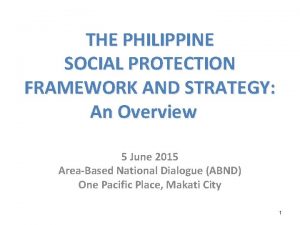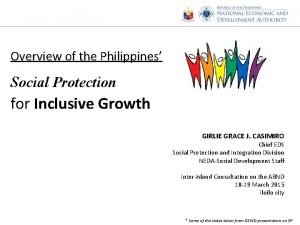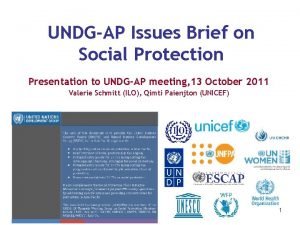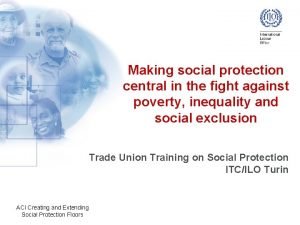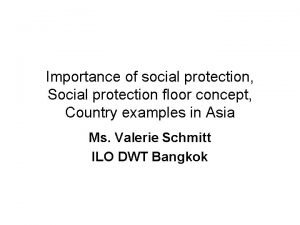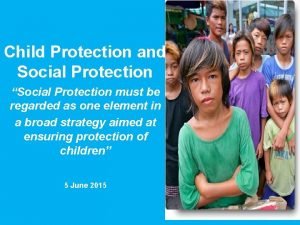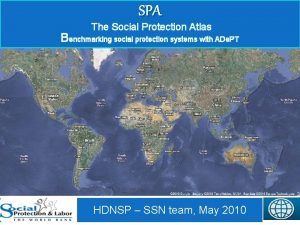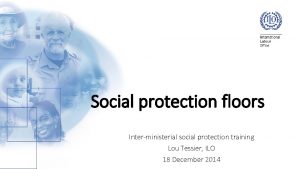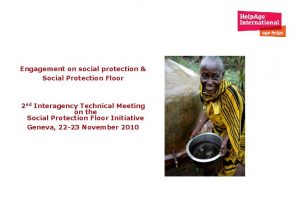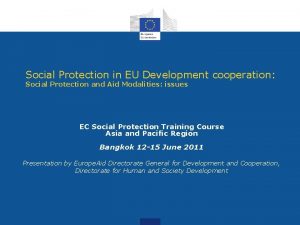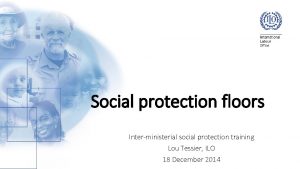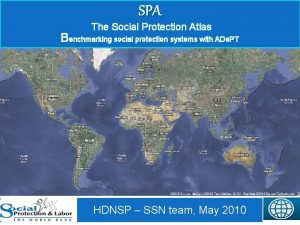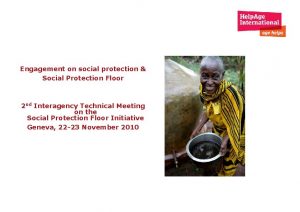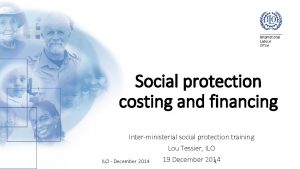Social Protection An overwiew of the concept of






























- Slides: 30

Social Protection • • An overwiew of the concept of social protection Gender issue Is the current model gender-equal? Group-work Making transition just for women

Social protection The 17 Sustainable Development Goals and 169 targets. They are integrated and indivisible and balance three dimensions of sustainable development: • economic, • social and • environmental. The three dimensions of sustainable development are clearly inter-dependent.

Why do we need social protection? Basic assumption: Throughout their life, all men and women are exposed to a wide and differing range of contingencies. Exposure to risk is undoubtedly part of the human condition. All populations are susceptible to adverse shocks resulting from natural, health, social, economic, political, and environmental risks

These risks are not evenly distributed among all men and women---- hence not equally exposure. Because of socio-demographic characteristics, economic status, physical or mental condition, age, lifestyle and so forth.

Risks bring. . . Vulnerability is a state of high exposure to certain risks, combined with a reduced ability to protect or defend oneself against those risks and cope with their negative consequences

According to ILO estimates, in 2012 only 27% of the working-age population and their families across the globe had access to comprehensive social security systems. 73%, of the world’s population, 5. 2 billion people, do not enjoy access to comprehensive social protection. CONSEQUENCES:

The lack of access to social protection: major obstacle to economic and social sustainable development is associated with high and persistent levels of poverty and economic insecurity in some parts of the world (e. g. World Bank, 2014), high and growing levels of inequality (UNDP, 2014; UN, 2013 d; UNRISD, 2010), insufficient investments in human development and human capabilities, and weak automatic stabilizers of aggregate demand in the event of economic shocks

If we put social protection as a policy area into this visionary approach, it is really about saying that there is a right to education, there is a right to health, there is a right to water, and there is a right to social protection…. BUT all these rights are very well, but be realistic, we have a limited budget, and we have to spend our money well!!!

Social protection policies contribute to fostering both Economic and Social development in the short and the long term, by ensuring that people enjoy income security, have effective access to health care and other social services, and are empowered to take advantage of economic opportunities. They play a key role in boosting domestic demand, supporting structural transformation of national economies, promoting decent work, and fostering inclusive and sustainable growth (e. g. G 20, 2011; G 20, 2012; ILO, 2012 a; OECD, 2009 a; World Bank, 2012).

Considerations. . . • there is a lot of impact of an economic nature to bring into the discussion, because that is what obviously will have more impact on pragmatic policy decisions. • When we are looking at social protection what the government is meant to be providing in terms of public goods. This means, firstly, it is a right. Secondly, it has to be funded from government resources (a good social protection floor is only as good as its redistributive function)

Social protection measures are essential elements of a policy response that can address challenges. Sustainable and equitable growth cannot be achieved in the absence of strong social protection policies which guarantee at least a basic level of social protection to all in need and progressively extend the scope and level of social security coverage. Such basic levels of social security should be guaranteed as part of national social protection floors, which constitute the fundamental elements of national social security systems

The ILO strategy on the extension of social protection is based on the two-dimensional strategy adopted by the 100 th Session of the International Labour Conference in 2011. This two-dimensional approach aims at the rapid implementation of national social protection floors containing basic social security guarantees that ensure universal access to essential health care and income security at least at a nationally defined minimum level (horizontal dimension), in line with the Social Protection Floors Recommendation, 2012 (No. 202) , and the progressive achievement of higher levels of protection (vertical dimension) within comprehensive social security systems according to the Social Security (Minimum Standards) Convention, 1952 (No. 102)

Gender Issues “These risks are not evenly distributed among all men and women---- hence not equally exposure. ” Importance of social protection policies

GENDER ROLES PUBLIC SPHERE PRODUCTIVE WORK RECOGNIZED and REMUNERATED ACCESS to OPPORTUNITIES and CAPITAL STEP 1. INTRODUCTION PRIVATE SPHERE REPRODUCTIVE WORK NOT RECOGNIZED and NOT REMUNERATED less ACCESS to OPPORTUNITIES and CAPITAL SELF-DETERMINATION/ DEPENDENCE/POVERTY/ SOCIAL INCLUSION SOCIAL EXCLUSION/ 14

GENDER EQUALITY FORMAL EQUALITY: assuring that women and men have the SAME STARTING POINT IN SOCIETY / STEP 1. INTRODUCTION SUBSTANTIAL EQUALITY: assuring that women and men have the RUN THE SAME DISTANCE to achieve social inclusion and opportunities 15

GENDER MAINSTREAMING STEP 1. INTRODUCTION ILO defines “gender mainstreaming” as the “process of assessing the implications for women and men of any planned action, including legislation, policies or programmes, in any area and at all levels and for making the concerns and experiences of women and men an integral part of the design, implementation, monitoring and evaluation of policies and programmes”. 16

Gender Mainstreaming in JUST TRANSITION? 1. WHERE ARE WOMEN AND MEN? STEP 1. INTRODUCTION 2. WHERE CAN WOMEN AND MEN BE? 17

Is the current model GENDER-EQUAL? STEP 2. CURRENT MODEL 18

GROUP WORK ENVIRONMENTAL, SOCIAL AND ECONOMIC VULNERABILITY: GENDER-NEUTRAL? Participants will be quickly divided in 3 groups. Each group will have 15 minutes to gather and agree key-ideas to the following questions: • GROUP 1: Do women and men face the same level of SOCIAL vulnerability? (Why? One example? ) • GROUP 2: Do women and men face the same level of ECONOMIC vulnerability? (Why? One example? ) • GROUP 3: Do women and men face the same level of ENVIRONMENTAL vulnerability? (Why? One example? )

A) SOCIALLY: think of SOCIAL PROTECTION SELF-DETERMINATION/ Lower SOCIAL INCLUSION maternity protection DEPENDENCE/POVERTY/ SOCIAL EXCLUSION Lower access to essential services (health, education, housing, water…) STEP 2. CURRENT MODEL Lower protection of occupational safety and health LOWER SOCIAL PROTECTION COVERAGE (both at the level of Social COVERAGE ( Protection Floor and at the level of contributive system) Lower unemployment 20 Lower benefits pensions Lower income security

B) ECONOMICALLY: think of EMPLOYMENT STEP 2. CURRENT MODEL Lower contribution to Social Protection PRODUCTIVE WORK REPRODUCTIVE WORK Less and worse green jobs opportunities SEXUAL DIVISION OF WORK Lower carrier Lower opportunities Employment EMPLOYMENT Rate Double DISCRIMINATION burden Higher unemployment rate Gender Pay-Gap Labour Segregation 21

STEP 2. CURRENT MODEL ENVIRONMENTALLY: think of CLIMATE CHANGE Employment higher vulnerability (i. e. agriculture) ACCESS to OPPORTUNITIES and CAPITAL Higher dependence on natural resources Lower Social Protection less ACCESS to OPPORTUNITIES and CAPITAL high participation of women in agriculture in many developing countries Lower resistance to economic and environmental distress. Less access to land, credit, agricultural inputs, decision-making bodies, technology and training services HIGHER VULNERABILITY facing CLIMATE CHANGE Role in nature resource management at risk More severe impact on 22 their livelihoods

Is the current model GENDER-EQUAL? STEP 2. CURRENT MODEL 23

MAKING TRANSITION “JUST” FOR WOMEN: 3 STRATEGIES GREEN AND DECENT JOBS SOCIAL PROTECTION STEP 3. STRATEGIES FOR CHANGE PARTICIPATION 24

GREEN AND DECENT JOBS for WOMEN (TODAY) STEP 3. STRATEGIES FOR CHANGE Primary Sector: 2% in developed countries (large scale mechanized agriculture) to 60% in some African and Asian Countries BUT mainly informal and marginalized) -Secondary Sector: where the majority of green jobs are expected to be created (construction, manufacturing, energy). Women are estimated to have less than 25% of world manufacturing jobs (mass production lines/EPZ) -Tertiary Sector: more than 50% of the women are providing services in social and administrative work (while men in business, finance, engineering) 25

GREEN AND DECENT JOBS for WOMEN (TOMORROW) STEP 3. STRATEGIES FOR CHANGE EMPLOYED ORGANIZED PAID EQUITABLIY RECRUITED TRAINED 26

EXTENSION OF SOCIAL PROTECTION FOR WOMEN STEP 3. STRATEGIES FOR CHANGE VERTICAL EXTENSION BENEFITS FORESEEN BY ILO C. 102 WORKFAMILY CONCILIATI ON POLICIES ACCESS TO ESSENTIAL SERVICES SOCIAL TRANSFERS for INCOME SECURITY HORIZONTAL EXTENSION 27

WOMEN’S PARTICIPATION IN DECISION-MAKING PROCESSES STEP 3. STRATEGIES FOR CHANGE • Promote women’s membership in workers’ and employers’ organizations and coverage by collective agreement, in particular in new green sectors; • Increase public participation of under-represented groups (such as indigenous women, migrant and rural women workers whose jobs and incomes directly rely on natural resources); • Rio Declaration, principle 10: • Assure access to information concerning the environment that is held by public authorities; • Assure effective access to judicial and administrative proceedings, including redress and remedy. 28

YOUR CONCLUSIONS? USEFUL ? FEASIBLE? STEP 4. CONCLUSION CLEAR? And now what? 29

Comments and suggestions welcomed!! ACTRAV 30
 Social thinking and social influence in psychology
Social thinking and social influence in psychology Social thinking social influence social relations
Social thinking social influence social relations Social protection operational framework philippines
Social protection operational framework philippines Social protection instruments
Social protection instruments Social protection operational framework philippines
Social protection operational framework philippines Social protection
Social protection Handle information in care settings
Handle information in care settings Ilo social protection
Ilo social protection Hát kết hợp bộ gõ cơ thể
Hát kết hợp bộ gõ cơ thể Frameset trong html5
Frameset trong html5 Bổ thể
Bổ thể Tỉ lệ cơ thể trẻ em
Tỉ lệ cơ thể trẻ em Chó sói
Chó sói Chụp tư thế worms-breton
Chụp tư thế worms-breton Bài hát chúa yêu trần thế alleluia
Bài hát chúa yêu trần thế alleluia Các môn thể thao bắt đầu bằng từ đua
Các môn thể thao bắt đầu bằng từ đua Thế nào là hệ số cao nhất
Thế nào là hệ số cao nhất Các châu lục và đại dương trên thế giới
Các châu lục và đại dương trên thế giới Công của trọng lực
Công của trọng lực Trời xanh đây là của chúng ta thể thơ
Trời xanh đây là của chúng ta thể thơ Cách giải mật thư tọa độ
Cách giải mật thư tọa độ Làm thế nào để 102-1=99
Làm thế nào để 102-1=99 Phản ứng thế ankan
Phản ứng thế ankan Các châu lục và đại dương trên thế giới
Các châu lục và đại dương trên thế giới Thể thơ truyền thống
Thể thơ truyền thống Quá trình desamine hóa có thể tạo ra
Quá trình desamine hóa có thể tạo ra Một số thể thơ truyền thống
Một số thể thơ truyền thống Cái miệng xinh xinh thế chỉ nói điều hay thôi
Cái miệng xinh xinh thế chỉ nói điều hay thôi Vẽ hình chiếu vuông góc của vật thể sau
Vẽ hình chiếu vuông góc của vật thể sau Thế nào là sự mỏi cơ
Thế nào là sự mỏi cơ đặc điểm cơ thể của người tối cổ
đặc điểm cơ thể của người tối cổ


